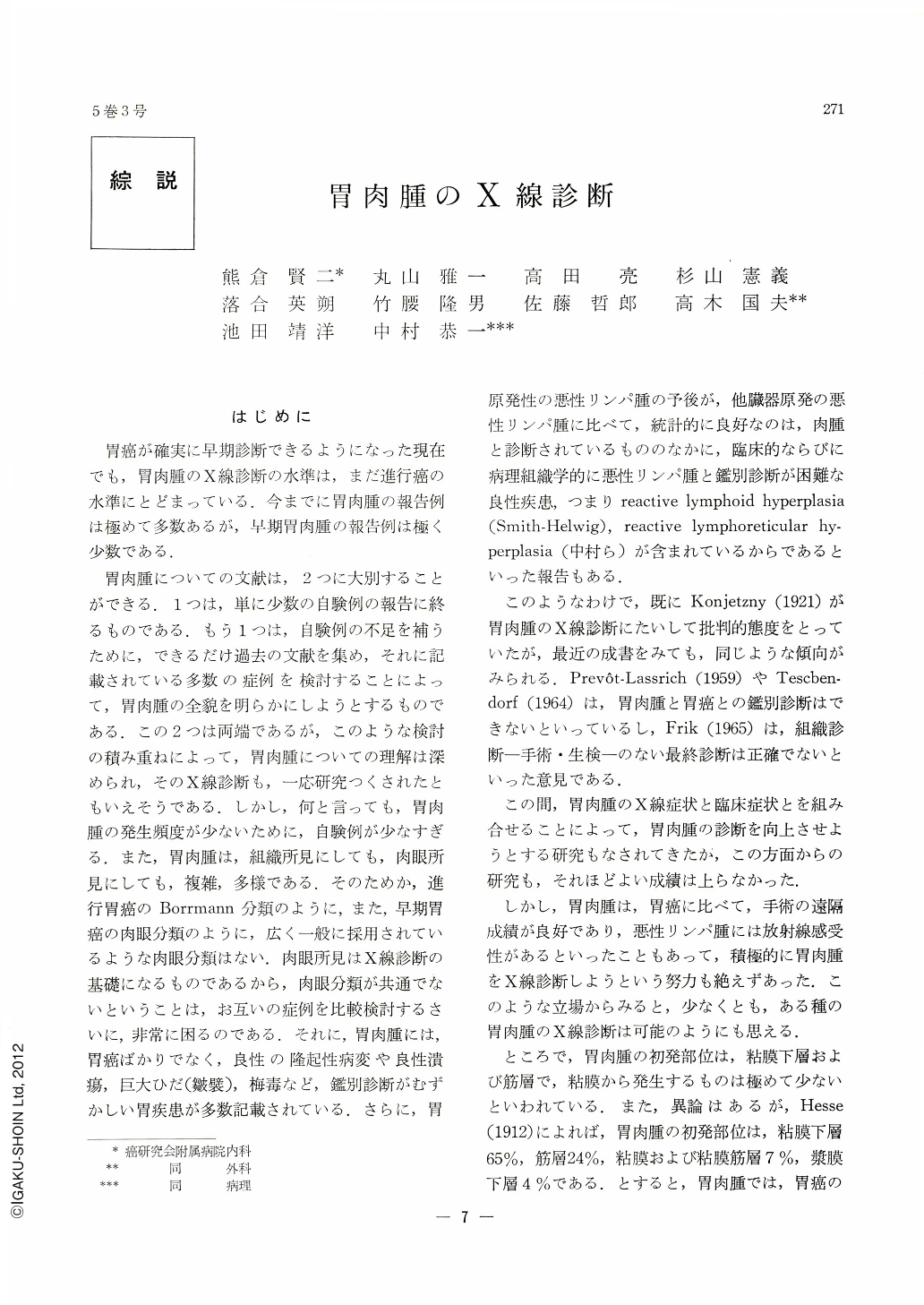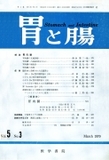Japanese
English
- 有料閲覧
- Abstract 文献概要
- 1ページ目 Look Inside
- サイト内被引用 Cited by
はじめに
胃癌が確実に早期診断できるようになった現在でも,胃肉腫のX線診断の水準は,まだ進行癌の水準にとどまっている.今までに胃肉腫の報告例は極めて多数あるが,早期胃肉腫の報告例は極く少数である.
胃肉腫についての文献は,2つに大別することができる.1つは,単に少数の自験例の報告に終るものである.もう1つは,自験例の不足を補うために,できるだけ過去の文献を集め,それに記載されている多数の症例を検討することによって,胃肉腫の全貌を明らかにしようとするものである.この2つは両端であるが,このような検討の積み重ねによって,胃肉腫についての理解は深められ,そのX線診断も,一応研究つくされたともいえそうである.しかし,何と言っても,胃肉腫の発生頻度が少ないために,自験例が少なすぎる.また,胃肉腫は,組織所見にしても,肉眼所見にしても,複雑,多様である.そのためか,進行胃癌のBorrmann分類のように,また,早期胃癌の肉眼分類のように,広く一般に採用されているような肉眼分類はない.肉眼所見はX線診断の基礎になるものであるから,肉眼分類が共通でないということは,お互いの症例を比較検討するさいに,非常に困るのである.それに,胃肉腫には,胃癌ばかりでなく,良性の隆起性病変や良性潰瘍,巨大ひだ(皺襞),梅毒など,鑑別診断がむずかしい胃疾患が多数記載されている.さらに,胃原発性の悪性リンパ腫の予後が,他臓器原発の悪性リンパ腫に比べて,統計的に良好なのは,肉腫と診断されているもののなかに,臨床的ならびに病理組織学的に悪性リンパ腫と鑑別診断が困難な良性疾患,つまりreactive lymphoid hyperplasia(Smith-Helwig),reactive lymphoreticular hyperplasia(中村ら)が含まれているからであるといった報告もある.
このようなわけで,既にKonjetzny(1921)が胃肉腫のX線診断にたいして批判的態度をとっていたが,最近の成書をみても,同じような傾向がみられる.Prevôt-Lassrich(1959)やTescbendorf(1964)は,胃肉腫と胃癌との鑑別診断はできないといっているし,Frik(1965)は,組織診断―手術・生検―のない最終診断は正確でないといった意見である.
この間,胃肉腫のX線症状と臨床症状とを組み合せることによって,胃肉腫の診断を向上させようとする研究もなされてきたが,この方面からの研究も,それほどよい成績は上らなかった.
しかし,胃肉腫は,胃癌に比べて,手術の遠隔成績が良好であり,悪性リンパ腫には放射線感受性があるといったこともあって,積極的に胃肉腫をX線診断しようという努力も絶えずあった.このような立場からみると,少なくとも,ある種の胃肉腫のX線診断は可能のようにも思える.
ところで,胃肉腫の初発部位は,粘膜下層および筋層で,粘膜から発生するものは極めて少ないといわれている.また,異論はあるが,Hesse(1912)によれば,胃肉腫の初発部位は,粘膜下層65%,筋層24%,粘膜および粘膜筋層7%,漿膜下層4%である.とすると,胃肉腫では,胃癌のような早期診断はむずかしいであろう.以上が,胃肉腫X線診断に関係のある事項のあらましである.どうも,混乱していて,明快ではない.この傾向は,悪性リンパ腫で特に著しい.そこで,今回は,紙数の関係で,胃の細網肉腫のX線診断について検討することにする.
In the years 1946 to 1969, a series of 52 cases of gastric sarcoma have been operated on in the Department of Surgery, Cancer Institute Hospital, including 38 cases of malignant lymphoma (36 reticulum cell sarcomas, 1 lymphosarcoma and 1 Hodgkin's sarcoma), 12 cases of leiomyosarcoma and 2 other varieties of sarcoma (one a melanosarcoma and the other a neurilemoma). Of these, reticulum cell sarcoma, now most at issue, has been studied in this paper.
Macroscopically it is classified into 4 types
Ⅰ. Polypoid type
a) pedunclated
b) flat, elevated
c) with thickened folds
Ⅱ. Localized, ulcerating type
a) exogastric
b) intramural
c) endogastric
Ⅲ. Intermediate type
1. Ulceration with no distinct marginal protrusion
a) exogastric
b) intramural
2. Ulceration with giant folds around it
Ⅳ. Diffuse type
1. Giant folds
2. Nodular or massive protrusion
3. Ⅱc like
X-ray findings of reticulum cell sarcoma are as follows:
(The polypoid type is so small in number that it is omitted here.) Ulcerating type (Ⅱ & Ⅲ) shows very similar findings to those of carcinoma of Borrmann's types Ⅱ and Ⅲ. In the localized, ulcerating type, a sharply demarcated smooth crater, almost characteristic of malignant lymphoma or reticulum cell sarcoma, is sometimes recognized. In the intermediate type, multiple ulcers are observed as well as giant rugae around them. Its exogastric type can sometimes be visualized as a pale shadow outside the stomach even in a simple x-ray picture. The most distinguishing feature of this variety is that narrowing of the gastric lumen is slight as compared with the extensiveness of the lesion. This is of utmost importance in the differentiation between it and cancer or benign tumors. Although it has been shown in the literature that lesions belonging to intermediate type should be discriminated from benign neoplasms, it was more of a problem in our cases to do so from reactive lymphoreticular hyperplasia. The diffuse type has such roentgenologic distinction as giant folds and nodular or massive protrusion, in addition to multiple ulcers of various sizes. These findings merit attention in the diagnosis of this variety of reticulum cell sarcoma. Most important of all, however, is the fact that narrowing of the gastric lumen is slight, if any, in comparison with the extent of the tumor. Unlike in the literature, 2cases of esophageal involvement have been experienced in our cases. No esophageal dilatation was seen, but there were distinct shadow defects in the lower segment of the esophagus in x-ray pictures.
According to the literature, the differential diagnosis includes cancer, benign tumors and ulcers of the stomach as well as giant rugae. We think early gastric cancer and reactive lymphoreticular hyperplasia should be included in it as well.

Copyright © 1970, Igaku-Shoin Ltd. All rights reserved.


